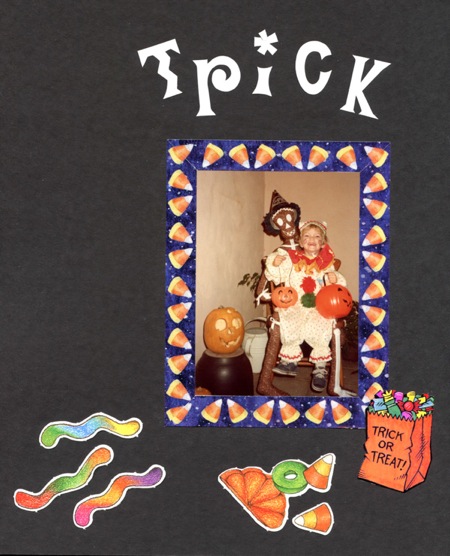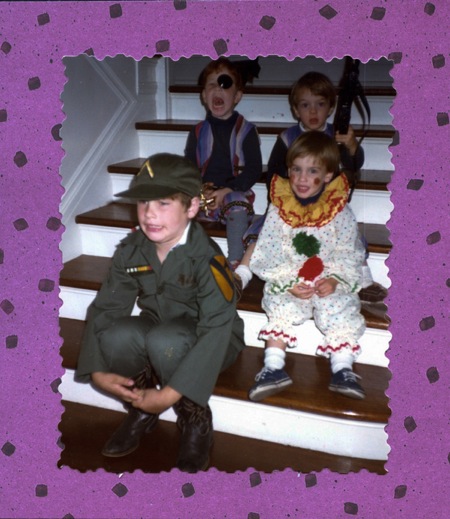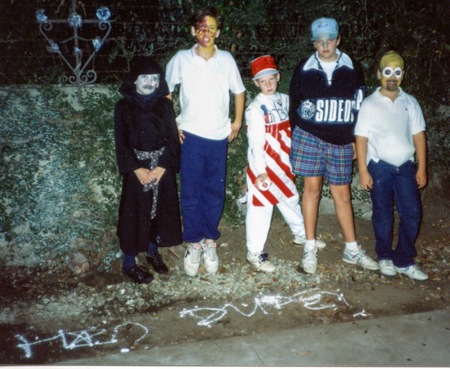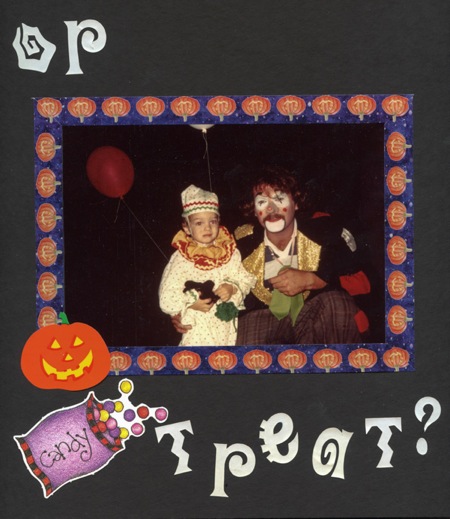
The Halloween costumes in our family have always been the product of “loving hands at home.” Guided by whim, mischief or childhood obsession, we managed to transform our little angels into circus performers, soldiers, and skeletons. Some of the results are embarrassing to look at in photos; I can only imagine the terror of wearing that get-up.
Our sons were part of a mob of six male cousins who lived within spitting distance of each other. Their Catholic grade school held a Harvest Festival each year where the children paraded around the field in their costumes. We never won any prizes, but we never failed to amaze the crowd.

With six boys each one to two years apart, Halloween was a “one-up-you” affair. When the oldest boy hit fifth grade and discovered American history, the outfits began a decline into battlefield gore.
Two of the boys favored military figures — we had George Washington, an anonymous Union soldier, a frontier cavalryman, and a Vietnam recruit. They each had a turn as a pirate (I sewed two purple striped costumes long before Johnny Depp), and we cheered The Lone Ranger, the Karate Kid, Sherlock Holmes, and assorted sports figures.
My favorite was the Barbasol Man, a feat of Halloween engineering created by my mother-in-law, an expert seamstress. A whilte pillowcase became a tunic sporting red barber-shop stripes; but it just didn’t have the desired impact until she added clear vinyl pockets and one can of Barbasol shaving cream in each pocket.
Our son arrived at the school festival and quietly armed his costume. The crowd of children parted like the proverbial Red Sea and the teachers descended upon him like a swarm of locusts. He was disarmed before he could deliver a squirt. But Barbasol Man remains a Halloween Heirloom.

Resurrecting Keepsake Halloween Costumes
Our costumes were well-used by the family and any friends who needed a quick “get-up” and were never really stored until the outfit was completely outgrown. Eventually they ended up in an old Army footlocker; and that’s where I found them last summer.
Get Rid of Mothball Smell
Someone helpfully scattered mothballs inside the trunk. No bugs or holes, just mothball stink. The first task was to air out the clothes. I spread out the clothes over bushes in the yard and left them for several days (it was summer). This wouldn’t be a good idea with delicate or fragile cloth, but most of these clothes were made of pretty stout stuff.
Next, I washed the items in cold water on gentle cycle in my washing machine, and put them on hangars to dry. Our grandson thought the colonial G.W. vest was a wonderful pirate’s vest.
Eliminate Old Stains
I set aside the clown suit last summer for some extra attention when I had more time.
Last week I took off the pom-pons and tackled the stains around the neck. Evidently the last toddler to wear it really enjoyed his Halloween candy.
Most advice for working with vintage textiles caution against harsh detergents; I just wanted to get out the stains. Internet forums suggested several options for working with old baby stains.
First, I tried a soaking the suit in a mixture of 1/2 cup powdered dishwasher detergent (like Cascade or Electrosol) and 1 gallon of warm water. I left the suit in the solution for about 30 minutes. The stain was definitely better, but not entirely gone, and the suit still smelled musty.
Next, I tried a fresh soak in Twenty Mule Team Borax, purported to be an old-fashioned laundry solution. Unfortunately, the powdered granules didn’t completely dissolve and couldn’t rinse them all out of the suit. Even dry, the suit feels gritty.
Finally, I just washed the suit in my front-loading washer using the Hand Wash setting and a very small amount of liquid detergent.
Success!

How to Preserve Keepsake Halloween Costumes
When I store the costumes again, I am going to do things differently, and follow a few guidelines learned in my research for How to Archive Family Keepsakes .
1. Clean clothes before storing. No matter how clean you think children’s clothes may be, over time any stains, odors, or dust will become ingrained in the fiber of the cloth. Clean the item appropriately before storing.
2. Avoid mothballs. Check the storage area for pests and air out the closet or container if needed.
3. Gently roll or fold the item using acid-free tissue or an old sheet to cushion layers, and place inside a clean cotton pillowcase.
4. Store the costumes in “archival” containers. Depending on how much you value the costume, there are several options: museum quality archival boxes, plastic storage boxes, a bureau drawer. Avoid placing the clothes in direct contact with wood or cardboard. I will probably put them back inside the old metal army trunk that is now well-aired and no longer holds the odor of mothballs.
Of course, this is just what worked for me with my 25-year old handmade costumes. You might want to be more cautious with vintage textiles or anything that includes other materials like beading, leather, or metal. Always consider the various ingredients of an item and handle accordingly. You can find more resources for preserving textiles and other keepsakes in my book How to Archive Family Keepsakes.
Disclosure: This website uses affiliate links. Thank you for supporting The Family Curator by shopping with our affiliates.





